Disconnecting drivetrain components, such as the E*Thirteen Sidekick hub and Ochain, and mass dampers are the hottest gizmos on the World Cup DH scene, and two patent applications show that Fox Suspension may have some exciting new wireless tech up its sleeve in these areas.
Fox Factory (known to most of us as Fox Suspension) has filed patent applications for a rear hub that automatically decouples from the chain’s forces, doing away with the age-old problem of pedal kickback by creating a ‘chainless’ suspension feel. And that’s not all; the US suspension brand has also applied for a patent around the hottest new gadget in downhill racing, the tuned mass damper.

The mass damper attached to Myriam Nicole’s Commencal Supreme is clearly visible bolted to the upper fork tubes next to the number plate // Bartek Wolinski / Red Bull Content Pool
This variation on the mass damper currently sported in different forms by the likes of Amaury Pierron, Ronan Dunne, Dakotah Norton and Loris Vergier, could be fitted to an existing shock or fork, or indeed anywhere on the frame, even the handlebars. A TMD is a weight suspended between springs, it works by cancelling out the natural frequency of bumps, to reduce the severity of vibrations and give a smoother ride and more grip. Will either of these new developments see the light of day? We’ll have to wait for the answer, but it’s exciting to see companies pursue these marginal gains in the name of performance.

Ronan Dunne’s rear mass damper can bee seen behind the brake disc on the prototype Mondraker Summum // Bartek Wolinski / Red Bull Content Pool
Fox decoupling hub and tuned mass damper patents need to know
- Hub would automatically disengage pawls depending on sensor information to eliminate pedal kickback on rough terrain – improving grip, comfort, and control
- System could also include an automatically disconnecting clutch in the derailleur to improve suspension freedom
- Tuned Mass Damper designed to reduce vibrations felt through the bike or specific components, such as handlebars
- Automatically adjustable for different terrain/components
- Potential to generate current to power different components or the overall system
- Plug-in cartridge options for steerer tubes and handlebars
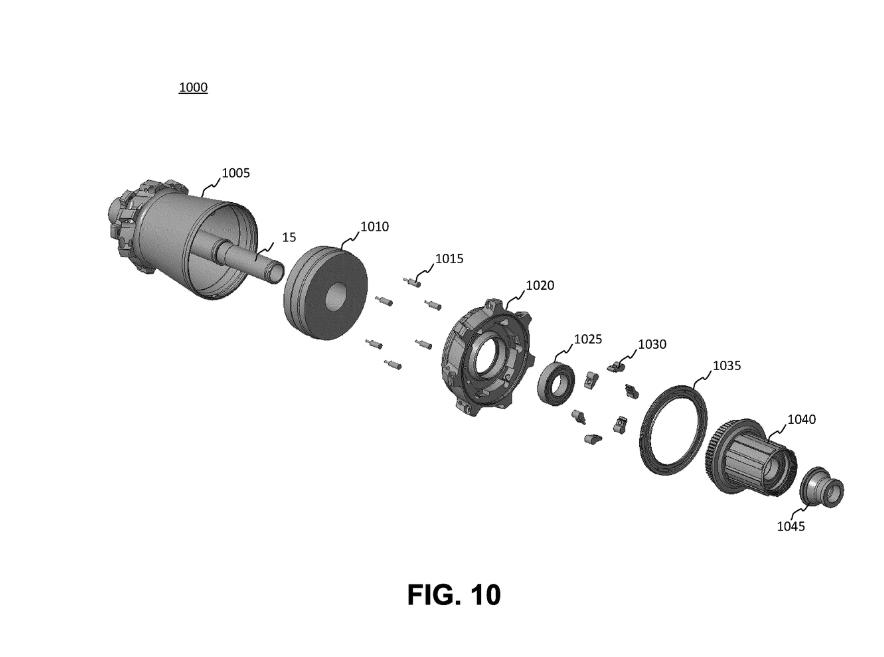
Exploded view of a potential electronic automatically decoupling hub design. Magnets in the pawls (1030) allow them to be engaged and disengaged from the ratchet ring (1020).
Fox’s decoupling hub
If it sees production, Fox’s new hub design would work electronically and automatically, the patent application shows, with signals from a “controller” going to “inductors/electromagnets”. Those inductors then control whether the freehub pawls are engaged to drive the hub, or disengaged to let it rotate freely without the interference of a chain. All with the aim of reducing pedal kickback in rough sections, giving better grip and more active suspension. But you could still have that chain tension engaged for pumping terrain or loading up the bike in supportive turns, like berms. The best of both worlds then? But wait, didn’t Canyon show off a similar prototype system at Eurobike eight years ago called the Disconnect?
You can bet your house that the new decoupler would be wireless too. Fox has just brought out its Live Valve Neo using its own wireless protocol to automatically and electronically disengage the rear shock. And the latest Fox Transfer Neo dropper post uses the same tech.
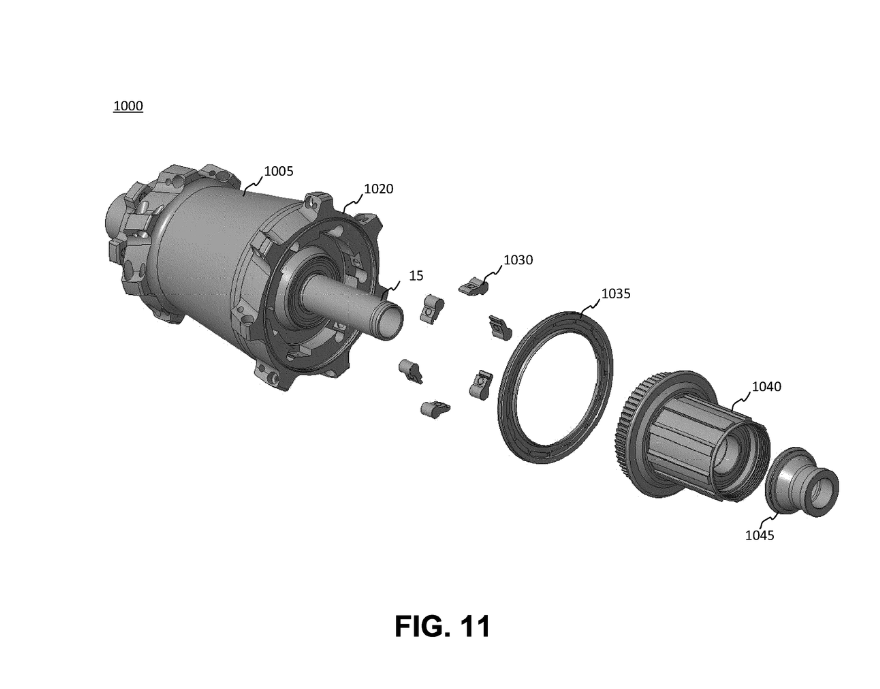
A closer look at that hub view with only the pawls, seal, cassette body, and and cap exploded.
I’m guessing now, but it seems logical that the hub would disengage when you’re not pedalling or ‘loading’ the chain when pumping, before near-instantly engaging when you want to put the power down again. Maybe there will be a torque sensor that detects pedalling input in conjunction with inertial sensors that know the gradient, acceleration/deceleration and bump inputs, and makes a decision whether to engage or disengage depending on those parameters. Perhaps there will even be a manual override button on the handlebars.
It’s going to use a camera now?!
What kind of sensor the hub would use to figure out if you’re pedalling is intriguing – Fox’s patent says it could be an “accelerometer, an optical detection device, or an image capturing device”. Does this mean Fox is going to use all three? An accelerometer to tell if you’re hauling ass or sending it off a jump perhaps, and an optical sensor to measure speed and distance? But the camera?! Of course it could just be a catch-all wording to prevent other companies from finding workarounds should the patent be granted.
Clearly it’s a hard piece of engineering to pull off. Riding chainless has famously powered the likes of Aaron Gwin to World Cup glory in Leogang, but it certainly feels different when you’re riding without one and the resulting ‘platform’ to push against. This system would potentially allow for the best performance in both situations, without the rubbery slack take-up and limited free movement of a system like the Ochain.

A derailleur showing the potential position of the automatic P-knuckle clutch disengagement device (510).
Disengageable derailleur clutch too
Fox also goes a step further with a patent for a “disengageable derailleur assembly” or more precisely a frame attachment system with a motor and gear and p-knuckle – the part that regulates the clutch tension. The important line from the patent is that the cage assembly can be “adapted to disengage from the P-Knuckle assembly during a chain growth or reduction event.” Or in other words, turn off the clutch mech when you’re compressing the bike’s suspension and then re-engage to ‘catch’ the chain before it slaps around or derails from the chainring.
Shimano invented the humble clutch mech to control the chain and stop it flapping against your chainstay, it’s an invention SRAM followed up with and it’s quickly become indispensable. Preventing that chain movement does interfere with the suspension movement though, and it looks like Fox’s idea is to automatically disengage this too. When it would disengage isn’t really clear from the patents of course, and I’ve got no idea how it would do this and still be effective at taming the chain, given the plan is to turn off the clutch when you’re deep into your travel.
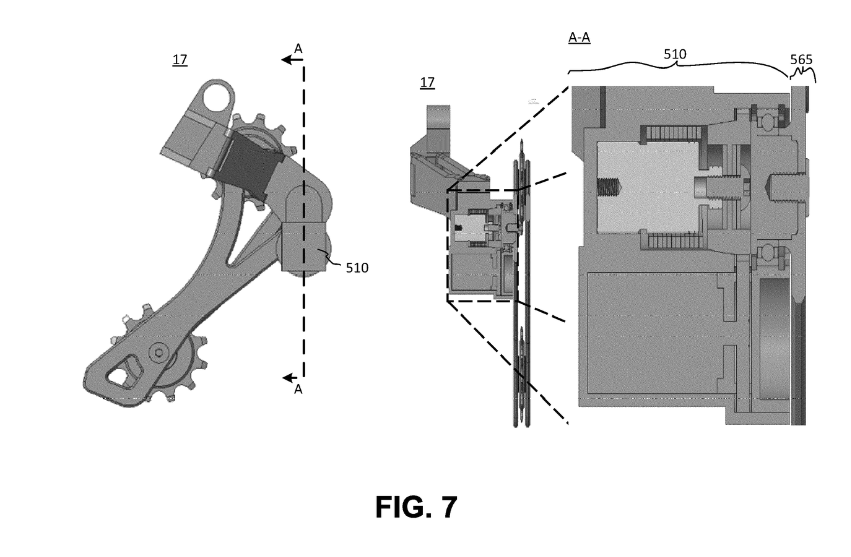
A cutaway view of the disengagable derailleur assembly. Various options are considered for the mechanical engagement and disengagement of the clutch, all electronically controlled.
What we do know is that this new mech assembly would probably use a linear solenoid to engage, according to the plans. Solenoids work by converting electromagnetism into mechanical motion, presumably closing and opening a valve to let the clutch move. Again, I’d see this as being controlled wirelessly, likely through the central brain of the Live Valve Neo system.
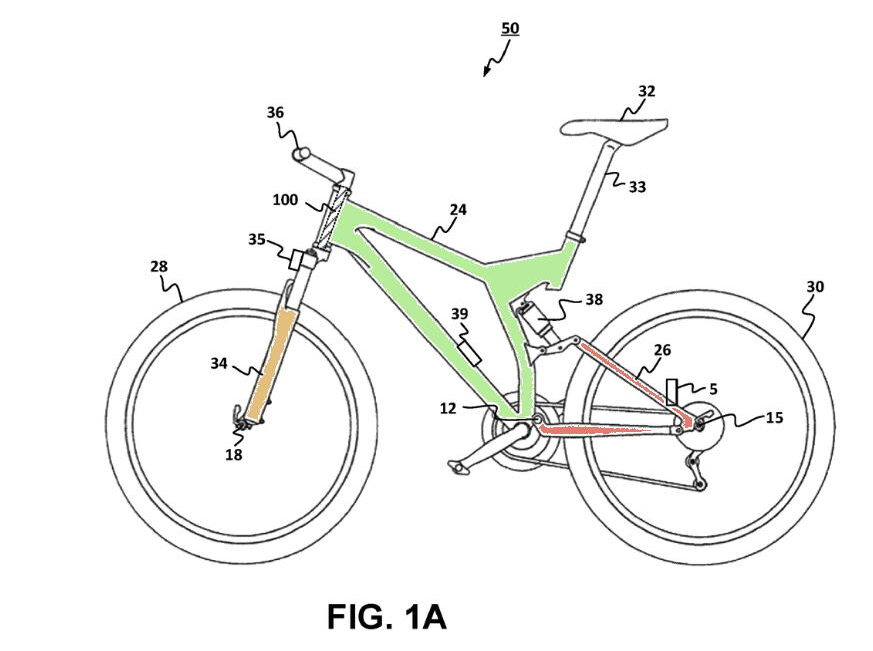
Perspective drawing of a bike with potential tuned mass damper positions on the fork, in the handlebars, in the steerer tube, on the seatstay, on the shock, on the down tube and even the saddle.
Fox’s tuned mass damper patent
Honestly, I’m amazed Fox didn’t get to TMDs a while back, given its suspension knowhow. As we’ve explained earlier, a tuned mass damper is a weight suspended on a spring, it’s there to match and cancel out vibrations and oscillations felt through the bike. There are already TMDs in the works from Rimpact and CounterShox, but Fox’s patent shows it wants to add a whole load of electronic wizardry to the process. The advantages were such in Formula 1 (reportedly 0.3 seconds a lap) that the FIA banned them in 2005.
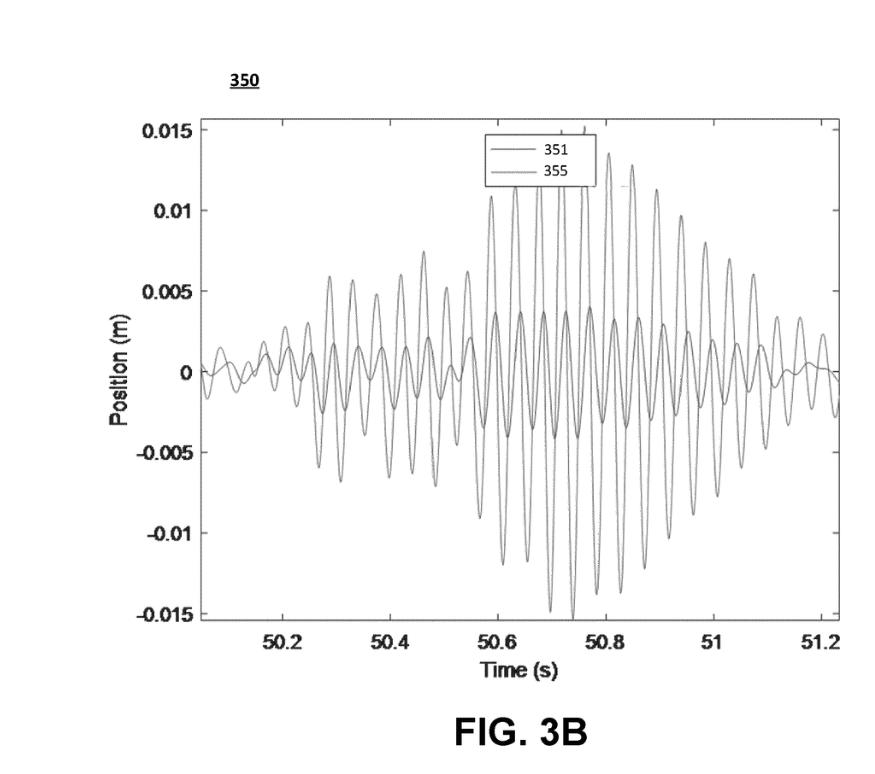
This graph shows forced vibrations through a fork with and without a tuned mass damper. The higher peaks without, and the lower peaks with. The TMD operating here in the fore-aft direction.
Specific dampers, adjustable dampers, and smart dampers
The spring is pretty straightforward, Fox mentions an adjustable air spring rather than a coil here. The damping coefficient, or how quickly it returns to rest after movement, is where things become really interesting though. If I’m reading the patent right, that damping will be controlled by a flow port with an electronically controlled valve, just like on Live Valve Neo. Inside will be “smart fluid” that’s magnetorheological and electrorheological – run a current through these and they instantly change viscosity, which can lock out or stiffen the damper. It’s the kind of tech loads of car and motorcycle companies have been using in their adjustable suspension systems.
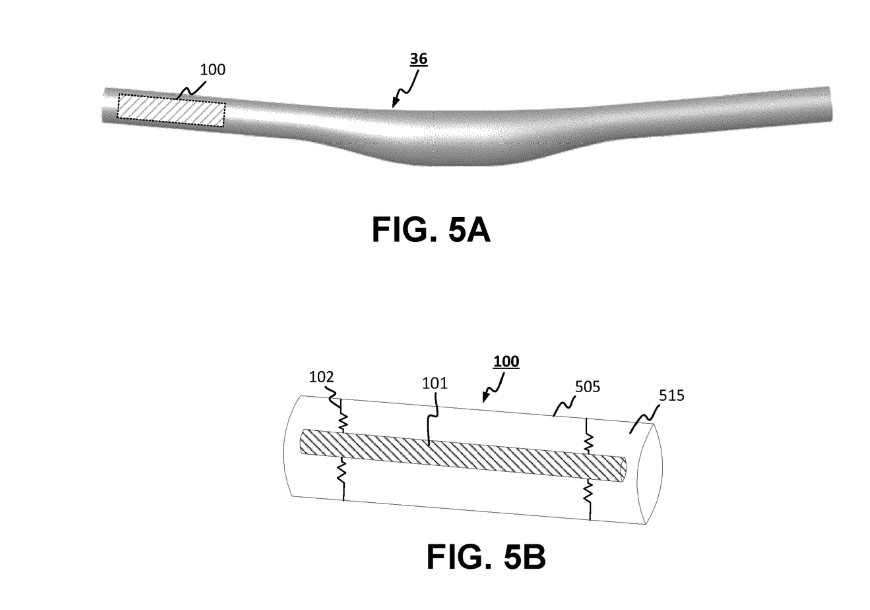
A tuned mass damper inside the ends of a handlebar is just one potential spplication.
There are other intriguing ideas contained in the text for the patent application. Such as sharing damping fluid between the main shock absorber and the mass damper, and using an electromagnet to generate energy to charge or power other components through the damping process. Fox suggests the mass damper could be fitted to, or integrated into the frame, fork, shock, or even a component, such as the handlebar. There’s also mention of a self-contained cartridge that could be inserted into the fork steerer or ends of the handlebar, making for easy potential upgrades. Fox also makes the point that different components resonate at different frequencies, so it could be that there are one or more tuned mass dampers specific to different components rather than one single unit. And the ability to change the tune of the mass damper specifically to the component is important, since an incorrectly tuned mass damper will actually negatively affect the peak vibration frequencies and reduce traction and control and increase fatigue.
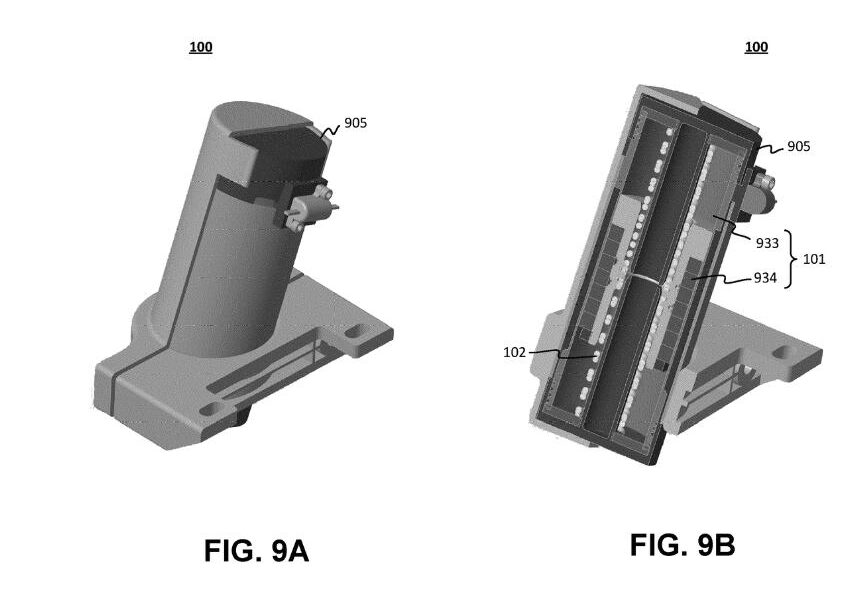
A possible tuned mass damper using electromagnets to generate power for the system or any other components.
The nitty gritty
As with any patent application, the detail is considerable, and the language is highly technical, so I may have missed some important bits, or misunderstood some sections. Because the aim is often to protect IP and prevent competitors from closing off certain product development routes, it can be very much a theoretical process and may not indicate a product in actual development. But it’s cool to speculate, right? And we all like to know what’s coming down the pipeline. If you want to dig into the details, Fox’s application for a hub decoupler is here, and the application for a tuned mass damper is here.




